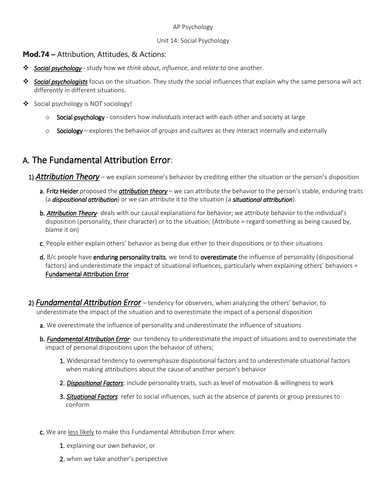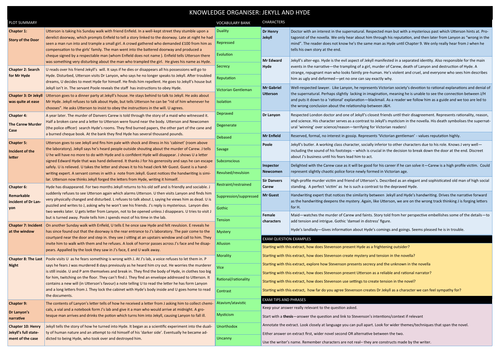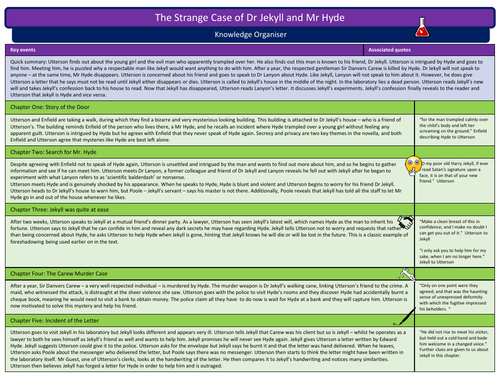
423Uploads
98k+Views
7k+Downloads
All resources

AP Psychology Social Psychology NOTES – Attribution, Attitudes, & Actions:
AP Psychology
Social Psychology
– Attribution, Attitudes, & Actions:

King Lear Worksheet
Unlock your students’ understanding of Shakespeare’s King Lear with this detailed and structured worksheet focused on Act 1 Scene 1. This resource is perfect for helping students engage deeply with the text, encouraging close reading and textual analysis.
Key Features:
Guided Questions with Embedded Quotes:
Students are prompted to answer key questions about the scene, with a selection of quotes provided to support their responses. This helps them practice using evidence from the text to back up their analysis, following the PEE (Point, Evidence, Explanation) structure.
Character Analysis:
Explore the motivations and emotions of key characters like Gloucester and King Lear. Students are encouraged to analyze Gloucester’s complex feelings toward his son Edmund and Lear’s reasons for dividing his kingdom.
Matching Exercise - Daughters’ Responses:
A creative and interactive task where students match each of Lear’s daughters (Goneril, Regan, and Cordelia) to the correct adjective that describes their nature, and then connect this to a corresponding quote from the text. This exercise aids in developing critical thinking and comprehension skills.

Writing Skills Checklist
Evaluate the following criteria in writing
IDEAS
ORGANIZATION
Paragraph organization
SENTENCE FLUENCY
VOICE
WORD CHOICE
CONVENTIONS

King Lear Act 1 Scene 5 Worksheet
Multiple Choice Questions
Four questions focusing on Act 1 of King Lear, specifically Lear’s actions and mental state. These questions assess students’ understanding of the early plot and the interactions between Lear, his daughters, and the Fool. Topics include Lear’s fear of madness, his confrontation with Goneril, and the role of the Fool as a truth-teller.
2. Fill-in-the-Blanks with Quotes
This section helps students recall and complete important quotes from the play. It includes four key quotes that deal with Lear’s growing awareness of his mistakes, his regret towards Cordelia, and his early expressions of madness.
3. PEE Chains (Point, Evidence, Explanation)
Two tasks encourage students to construct PEE paragraphs, which develop their ability to analyze Lear’s character development and his relationship with the Fool:
Task 1: Focuses on how Lear’s character changes from Act 1, Scene 1 to Act 1, Scene 5, particularly his growing fear of madness.
Task 2: Explores the Fool's role as Lear’s conscience and truth-teller, using sentence starters to help students analyze their interactions.
In both tasks, sentence starter suggestions for Point, Evidence, and Explanation are provided, giving students a structured approach to their analysis.
4. Matching Exercise – Quotes and Themes of Madness
This section is a matching exercise where students pair quotes from King Lear with corresponding themes related to madness. The quotes illustrate Lear’s fear of madness, regret, and identity crisis, while the themes highlight key aspects of Lear’s psychological unraveling and how it is reflected by the Fool.
The worksheet balances comprehension with deeper analysis, offering students both recall-based tasks and opportunities for analytical writing.

Narrative Writing Worksheet: Understanding Characters and Relationships Sally Rooney Normal People
Narrative Writing Worksheet: Understanding Characters and Relationships Sally Rooney Normal People

King Lear Act 1 Test
he King Lear Act 1 Test is a comprehensive assessment designed for 6th Year Leaving Certificate English students. The test evaluates students’ understanding of the main events, themes, characters, and literary techniques in Act 1 of King Lear.
Test Breakdown:
Part 1: Multiple Choice Questions (10 marks)
This section consists of 10 multiple-choice questions. Each question focuses on key moments, character actions, or significant quotes from Act 1. Students are required to select the correct answer from four choices.
Topics covered include:
Lear’s decision to divide his kingdom.
The roles of characters like Cordelia, Kent, and the Fool.
Key quotes and Lear’s emotional state by the end of Act 1.
Part 2: Fill-in-the-Gaps (11 marks)
This section requires students to complete missing words from important quotes in Act 1. A word bank is provided to assist students in filling in the blanks.
Example quotes include:
Lear: “How sharper than a __________’s tooth it is to have a __________ child!”
Fool: “Thou hadst little __________ in thy bald crown when thou gavest thy __________ one away.”
Part 3: Who Said It? (5 marks)
In this section, students match famous quotes from Act 1 to the correct character. Each quote is listed with four possible speakers, and students must identify who said it.
Key quotes include lines from Lear, Cordelia, Kent, and the Fool.
Part 4: Short Answer Questions (10 marks)
This section includes 10 short answer questions, requiring students to respond in 1–2 sentences. The questions focus on character actions, motivations, and significant plot points.
Example questions include:
How does Edmund manipulate his father Gloucester in Act 1?
What advice does the Fool give to Lear in Scene 4?
Part 5: Character Analysis (20 marks)
This section is the most detailed part of the test, asking students to choose one of three essay-style questions to answer. The focus is on analyzing key characters (Lear, the Fool, Goneril, and Regan) and how they are developed in Act 1. Students are expected to refer to key quotes and techniques used by Shakespeare.
Example essay questions include:
Analyze King Lear’s actions in Act 1. How do his decisions to divide the kingdom and test his daughters reflect his personality flaws?
Discuss the role of the Fool in Act 1. How does he use humor and criticism to help Lear understand his mistakes?

Where the Crawdads Sing
Where the Crawdads Sing", is a comprehensive teaching resource based on Delia Owens’ novel. It includes:
Book Introduction and Reviews: Provides critical insights and context for the novel, including thematic connections to nature, isolation, and human relationships. This section could be used to initiate classroom discussions and offer students a deeper understanding of the novel’s critical reception.
Chapter Summaries: Organized by parts and chapters, this breakdown offers a clear roadmap of the novel’s structure, which teachers can use to guide lessons, assign readings, or discuss key plot points.
Character Analyses: Detailed profiles of key characters like Kya, Tate, and Chase Andrews are provided, enabling teachers to explore character development, motivations, and relationships. These profiles also offer quotes that can be used for in-class analysis.
Discussion Questions: Thought-provoking questions are available for every major plot point and theme, ideal for fostering critical thinking, class debates, and deeper understanding of character dynamics and thematic elements.
Historical Context and Setting: Explains the relevance of the marshland setting, Kya’s isolation, and how the environment mirrors her personal struggles. This can be integrated into lessons on geography, history, or literature, helping students to connect the setting with the protagonist’s development.
Nature Journal Activity: An interactive task idea where students create a nature journal, encouraging creativity and a deeper connection to the natural world—one of the novel’s central themes.

Where the Crawdads Sing - Introduction
The PowerPoint slides on “Where the Crawdads Sing” offer a structured and visually engaging digital product for teaching Delia Owens’ novel. Here’s a description of its features:
Character Profiles: The slides provide concise summaries of major characters such as Kya, Chase, Tate, and others. These summaries help students quickly grasp the roles and significance of each character in the narrative, making it easier for teachers to facilitate discussions or assignments on character development.
Setting & Timeline: The presentation includes information on the setting, particularly the marshlands of North Carolina, and the timeframe, which spans from 1952 to 2009. This context helps students understand the historical and geographical backdrop of the novel, encouraging connections between the environment and themes of isolation and survival.
Plot Structure & Narration: The slides explain the novel’s dual plotlines (Kya’s life story and the murder investigation) and the use of third-person narration, which guides students through the novel’s structure. This is useful for teaching narrative techniques and the impact of storytelling choices.
Thematic Development: Key themes such as abandonment, isolation, survival, and the role of nature are highlighted. This feature allows teachers to delve into thematic analysis with students, encouraging them to explore how these elements influence the characters and the plot.
Major Events & Questions: Important events like the discovery of Chase’s body, Kya’s life milestones, and the trial are outlined. Thought-provoking questions related to these events are integrated, ideal for prompting classroom discussions or essay prompts.
Visual & Interactive Elements: The slides incorporate visuals that complement the text, making it easier for students to engage with the material. Teachers can use these slides to create interactive lessons, encouraging students to explore the novel through visual storytelling and critical thinking exercises.

Comprehensive Study Guide for Chapter 1-9 Where the Crawdads Sing
Comprehensive Study Guide for Chapter 1-9 Where the Crawdads Sing
Dive into the world of Delia Owens’ Where the Crawdads Sing with this thorough study guide, designed for students, educators, and literary enthusiasts. This guide provides everything needed to explore the novel’s complex themes, characters, and social context, making it the ideal companion for both in-depth analysis and exam preparation.
Key Features:
Extended Literary Genre Analysis: Breaks down Owens’ narrative techniques, including the blend of murder mystery, coming-of-age, and nature writing. Analyzes how Owens’ unique storytelling style and use of symbolism, foreshadowing, and dual timelines bring depth to Kya’s journey of resilience and survival.
Detailed Cultural Context: Examines the social, cultural, and political landscape of the American South in the 1950s-60s. Insightful explanations cover Kya’s isolation due to class prejudice, gender expectations, racial segregation, and economic hardship, providing a fuller understanding of the novel’s social dynamics.
Character Development and Thematic Exploration: In-depth discussions of Kya’s emotional growth, survival instincts, and relationship with nature. Tracks her character evolution alongside themes of isolation, love, betrayal, and justice, using specific examples from the text to illustrate key moments.
Blended Genre and Structural Analysis: This guide outlines how Owens’ narrative blends different genres—from suspenseful murder mystery to lyrical nature writing. It breaks down the structural techniques, such as the prologue and dual timelines, that shape the novel’s pacing and reveal Kya’s inner world.
Essay and Discussion Prompts: Includes scaffolded essay tasks and prompts that encourage critical thinking and engagement with the text. Each task features a structured approach to help students explore Owens’ use of literary techniques and the novel’s cultural implications.
Benefits:
Enhanced Understanding: Offers a nuanced view of the novel’s literary and social elements, helping readers uncover layers of meaning behind Kya’s story and Owens’ narrative choices.
Comprehensive Study Aid: Perfect for exam preparation, assignments, or literary discussions, this guide condenses essential analysis into structured sections for easy comprehension.
Insights on Key Themes and Symbols: Encourages deeper exploration of themes such as nature’s role as a nurturer, prejudice, loneliness, and the fight for identity, allowing readers to fully appreciate Owens’ thematic intentions.
Scaffolded Analysis for Essays and Exams: With clear essay structures and sample analyses, students can confidently develop well-rounded responses and insights for academic assessments.

King Lear - Themes Revision
Product Title: Comprehensive King Lear Theme and Justice Analysis Guide
Product Overview: This in-depth study guide offers a focused examination of key themes and justice in Shakespeare’s King Lear, designed for students and educators looking to explore the play’s complex moral and ethical questions. It delves into two critical areas: the dynamics of love and different forms of justice—divine, human, and social—within the play, providing structured analyses, key quotes, and discussion prompts.
Features:
Thematic Exploration:
Detailed breakdown of love in King Lear with examples of pure, selfless love vs. selfish, corrupt love.
Examination of how love is developed through character arcs, pivotal scenes, and turning points.
Discussion on the relationship between love and loyalty, highlighting characters such as Cordelia, Kent, and Edgar.
Justice in King Lear:
Thorough analysis of divine, human, and social justice, discussing characters’ actions and their consequences in terms of morality.
Insight into Shakespeare’s reflection on divine justice and human suffering, with Gloucester and Edgar’s moral journeys highlighted.
Critical Thinking Prompts:
Guided questions to help students analyze the introduction, development, and resolution of themes.
Opportunities to reflect on the relevance of these themes in understanding human behavior and societal constructs.
Ideal For:
High school and university students studying Shakespeare.
English literature teachers seeking classroom resources.
Anyone preparing for essay writing or exams focused on King Lear.
This guide simplifies complex ideas, providing accessible yet detailed content, perfect for boosting comprehension of one of Shakespeare’s most profound tragedies.

King Lear Act 3 Revision Worksheet
Plot Summary
Summarize key events in each scene of Act 3, focusing on character actions and developments that drive the plot forward. This includes Edmund’s deception, Lear’s reaction to the storm, and Gloucester’s loyalty to Lear.
Key Quotes
Identify and interpret significant quotes in Act 3, connecting them to characters’ emotions, conflicts, and themes, like Lear’s mental turmoil and his view of justice.
Themes
Explore the main themes of Act 3, including Madness, illustrated by Lear’s descent into confusion, and Loyalty and Betrayal, highlighted through Gloucester’s loyalty to Lear despite betrayal.
Character Development
Examine character growth in Act 3, especially focusing on Lear’s reflections during the storm and Gloucester’s moral choices, revealing shifts in their priorities and self-awareness.
Multiple-Choice Questions
Test comprehension with multiple-choice questions that reinforce understanding of key moments and character motivations in Act 3.

King Lear Act 3 scene 4 Worksheet Quiz
This King Lear Act 3, Scene 4 Writing Task (Scaffolded) resource is a targeted worksheet designed to help students analyze Lear’s mental breakdown and evoke sympathy through structured writing. The worksheet combines multiple-choice questions, fill-in-the-blank exercises, and scaffolded paragraph tasks, offering students clear and practical steps to understand and explore key moments from Act 3, Scene 4.
Key Features:
Multiple-Choice Questions: Focused questions test students’ understanding of Lear’s actions, emotions, and interactions in Act 3, Scene 4.
Fill-in-the-Blank with Word Bank: Students complete sentences using key vocabulary, reinforcing their understanding of Lear’s mental state, Edgar’s disguise, and the symbolic storm.
Mix-and-Match Exercise: Students match Lear’s emotions, such as desperation, madness, and recognition of injustice, with specific quotes from the scene. This activity encourages critical thinking and direct engagement with the text.
Scaffolded Paragraph Writing:
Paragraph 1: Students analyze Lear’s disintegration, using a step-by-step process to incorporate quotes and analyze how his madness, bitterness, empathy, and recognition of injustice unfold in the scene.
Paragraph 2: Students write about whether they feel sympathy for Lear, following scaffolded prompts to consider Lear’s suffering and previous actions, with textual evidence to support their conclusions.
Educational Benefits:
Structured Learning: The scaffolded approach makes complex analysis more accessible, allowing students to gradually build strong analytical paragraphs.
Enhanced Critical Thinking: Through targeted questions and exercises, students are encouraged to think deeply about Lear’s emotional and psychological state.
Textual Engagement: The use of direct quotes helps students improve their understanding of Shakespearean language and its relation to character development.
Bundle

Visual Guide King Lear
The emoji visual guide for King Lear offers a simplified, engaging way to understand the play’s complex storyline, with each emoji representing key characters, events, and emotional tones in each act. Here’s a breakdown for each act:
Act 1 – The Kingdom’s Division 👑⚔️💔
The crown emoji represents King Lear and the kingdom.
Crossed swords symbolize the impending conflict and power struggle.
The broken heart conveys Lear’s pain as he divides his kingdom, expecting love but facing betrayal.
Act 2 – Rising Tensions 🏰👥👿
The castle represents the royal setting.
Two people emoji illustrate alliances and manipulations among characters.
The devil face highlights the deceitful plots by Goneril, Regan, and Edmund.
Act 3 – The Storm and Betrayal 🌩️🌲💨👑
The storm emoji captures the raging tempest that Lear endures, symbolizing his inner turmoil.
Trees indicate the forest, where many scenes unfold as Lear becomes homeless.
The wind emoji represents Lear’s vulnerability and madness.
The crown reminds us of Lear’s identity, now stripped of power.
Act 4 – Compassion and Schemes 👨🦯💔👸❤️
A man with a cane shows Gloucester’s blindness, and his loyalty despite his hardship.
The broken heart symbolizes the continued betrayal Lear faces from his daughters.
The queen (👸) and heart (❤️) show Cordelia’s compassion as she returns to save her father.
Act 5 – Tragedy Unfolds ⚔️💀👿💔👨👧⚰️
Crossed swords represent the battle between France and England.
The skull conveys the deaths and tragic fate of many characters.
The devil emoji highlights Edmund’s deceit and betrayal.
A broken heart shows the loss and sorrow felt, particularly by Lear.
The father-daughter emojis (👨👧) illustrate Lear’s heartbreaking reunion with Cordelia.
The coffin represents the tragic conclusion, marked by death and grief.




















